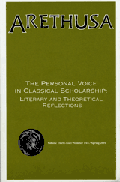 | |
| Discipline | Classics, cultural studies |
|---|---|
| Language | English |
| Edited by | Roger D. Woodard |
| Publication details | |
| History | 1967–present |
| Publisher | Johns Hopkins University Press (United States) |
| Frequency | Triannually |
| Standard abbreviations | |
| ISO 4 | Arethusa |
| Indexing | |
| ISSN | 0004-0975 (print) 1080-6504 (web) |
| OCLC no. | 31864718 |
| Links | |
Arethusa is an academic journal established in 1967. It covers the field of Classics using an interdisciplinary approach incorporating contemporary theoretical perspectives and more traditional approaches to literary and material evidence. It frequently features issues focused on a theme related the classical world. The current Editor in chief of the journal is Roger D. Woodard (SUNY Buffalo). The journal is named for the mythical nymph Arethusa and published three times each year in January, May, and September by the Johns Hopkins University Press.
Special Issues of Arethusa
The issues below are examples of themed issues from Arethusa.
5.1 Politics and Art in Augustan Literature (Spring 1972)[1]
7.1 Psychoanalysis and the Classics (Spring 1974)[2]
9.2 The New Archilochus (Fall 1976)[3]
13.2 Indo-European Roots of Classical Culture (Fall 1980) [4]
14.1 Virgil: 2000 Years (Spring 1981)[5]
17.2 Under the Text (Fall 1984)[6]
20.1/2 Herodotus and the Invention of History (Spring/Fall 1987)[7]
22 The Challenge of "Black Athena" (Fall 1989)[8]
27.1 Rethinking the Classical Canon (Winter 1994)[9]
33.2 Fallax Opus: Approaches to Reading Roman Elegy (Spring 2000)[10]
35.1 Epos and Mythos: Language and Narrative in Homeric Epic (Winter 2002)[11]
39.2 Ingens Eloquentiae Materia: Rhetoric and Empire in Tacitus (Spring 2006)[12]
41.1 Celluloid Classics: New Perspectives on Classical Antiquity in Modern Cinema (Winter 2008)[13]
49.2. Vitruvius: Text, Architecture, Reception (Spring 2016)[14]
53.2 Material Girls: Gender and Material Culture in Ancient Greece and Rome (Spring 2020)[15]
55.3 The Reception of Greek Tragedy: Studies in Celebration of the 90th Birthday of John J. Peradotto (Fall 2022)[16]
References
- ↑ Sullivan, J.P. (1972). "Politics and Art in Augustan Literature". Arethusa. 5 (1).
- ↑ "Psychoanalysis and the Classics". Arethusa. 7 (1). 1974.
- ↑ "The New Archilochus". Arethusa. 9 (2). 1976.
- ↑ Konstan, David (1980). "Indo-European Roots of Classical Culture". Arethusa. 13 (2).
- ↑ Putnam, Michael (1981). "Virgil: 2000 Years". Arethusa. 14 (1).
- ↑ "Under the Text". Arethusa. 17 (2). 1984.
- ↑ "Herodotus and the Invention of History". Arethusa. 20. 1987.
- ↑ Levine, Molly (1989). "The Challenge of "Black Athena"". Arethusa. 22.
- ↑ "Rethinking the Classical Canon". Arethusa. 27 (1). 1994.
- ↑ Fear, Trevor (2000). "Fallax Opus: Approaches to Reading Roman Elegy". Arethusa. 33 (2).
- ↑ Higbie, Carolyn (2002). "Epos and Mythos: Language and Narrative in Homeric Epic". Arethusa. 35 (1).
- ↑ Ash, Rhiannon; Malamud, Martha (2006). "Ingens Eloquentiae Materia: Rhetoric and Empire in Tacitus". Arethusa. 39 (2).
- ↑ Day, Kirsten (2008). "Celluloid Classics: New Perspectives on Classical Antiquity in Modern Cinema". Arethusa. 41 (1).
- ↑ Formisano, Marco; Cuomo, Serafina (2016). "Vitruvius: Text, Architecture, Reception". Arethusa (49.2).
- ↑ Lee, Mireille; Hackworth Petersen, Lauren (2020). "Material Girls: Gender and Material Culture in Ancient Greece and Rome". Arethusa. 53 (2).
- ↑ Woodard, Roger (2022). "The Reception of Greek Tragedy: Studies in Celebration of the 90th Birthday of John J. Peradotto". Arethusa. 55 (3).
External links